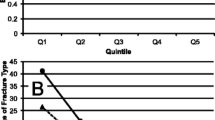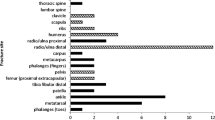Abstract:
In a prospective study of 348 apparently healthy women, aged 70 years and over (mean 80.3 years), we examined bone mineral density (BMD), biochemical markers of bone metabolism, and some easily measurable predictors in relation to hip and osteoporotic fractures. In addition, we constructed risk profiles for hip and osteoporotic fractures. At baseline, BMD at both hips, using dual-energy X-ray absorptiometry, body height and body weight were measured. At the same time, serum and urine samples were obtained for biochemical analysis. Serum samples were analyzed for vitamin D metabolites, sex hormone binding globulin, serum intact parathyroid hormone, osteocalcin, alkaline phosphatase, phosphate, albumin, calcium and creatinine. In 2 h fasting urine, hydroxyproline, type I collagen crosslinked N-telopeptide (NTx) and calcium excretion were measured. Furthermore, easily measurable predictors, such as previous fracture, body mass index (BMI) and mobility were assessed. During the follow-up period (mean duration 5.0 years), hip and any osteoporotic fracture (wrist, humerus or hip fracture) occurred in 16 and 33 participants, respectively. Data were analyzed using Cox regression analysis. BMD of the trochanter (per 1 SD decrease) and previous fracture were most strongly associated with hip fractures (adjusted relative risk (RR) = 3.0, 95% confidence interval (CI): 1.4–6.6; RR = 4.2, 95% CI: 1.5–11.6, respectively) and osteoporotic fractures (RR = 1.8, 95% CI: 1.1–2.8; RR = 2.9, 95% CI: 1.5–5.7, respectively). Previous fracture, BMI and mobility were identified as easily measurable predictors for hip fractures, whereas previous fracture, use of loop diuretics and age were predictors for osteoporotic fractures in the risk profile model. The risk of fractures can be predicted with three easily measurable predictors. This study confirms the importance of previous fracture as a predictor for hip fractures and other fractures. It also shows that the use of loop diuretics is a predictor for osteoporotic fractures.
Similar content being viewed by others
Author information
Authors and Affiliations
Additional information
Received: 28 January 1999 / Accepted: 29 June 1999
Rights and permissions
About this article
Cite this article
Tromp, A., Ooms, M., Popp-Snijders, C. et al. Predictors of Fractures in Elderly Women . Osteoporos Int 11, 134–140 (2000). https://doi.org/10.1007/PL00004174
Issue Date:
DOI: https://doi.org/10.1007/PL00004174




